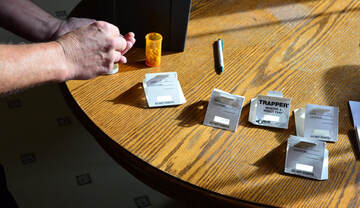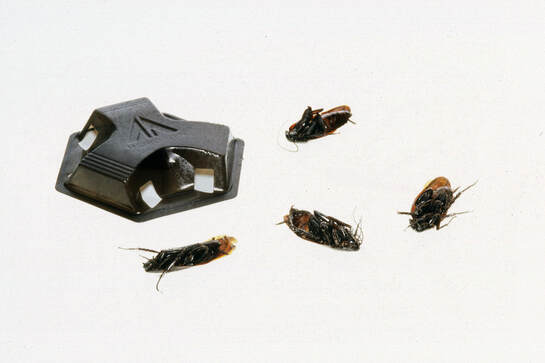|
Over the last couple of months on the Bug Lessons blog, we have taken a closer look at the specific components of IPM. We’ve gone over pest identification and setting guidelines to determine when to use what action. This month in our IPM series, we’re going to discuss the monitoring and assessment phase of an IPM plan. Monitoring helps you figure out where and how serious the problem is, while assessment helps you figure out if the program is working—read on to make sure you’re assessing pest situations properly! Pest IdentificationIf you recall, in our first couple of blogs, we emphasized a few criteria that need to be met before reaching the assessment/monitoring step. First, it is critical to properly identify the pest in question before engaging in any sort of pest management strategy. Once the pest is identified, you must set guidelines that dictate when action will be taken. This depends on the pest and the client in question. Once those steps have been taken, it is then time to start assessing pest numbers and damage to see whether i) actions you have taken previously are working, or, ii) whether or not action should be taken at this stage. For instance, monitors such as sticky traps used to identify the pest may have solved the problem if the pest issue was very mild. When assessing pest numbers and/or damage, a few things should be kept in mind, like:
Assessing the situation will require continued monitoring and frequent assessments that should be made during the monitoring process. There are a few ways to do this and use the information for assessment—each require a different amount of labor input. Casual ObservationCasual observation involves walking around the area and noting what you see. This might involve documenting obvious pest-conducive conditions that should be remedied (e.g., leaky pipes, spilled foods), observing obvious pest activity, or clear pest control action taken by the client (e.g., client-placed ant baits). Notes should be taken so that all information can be communicated to the client. For instance, if sanitation is recommended to prevent pest-conducive conditions—on the next follow up you can record whether or not these actions were taken. That information can be correlated to pest density. This strategy may be enough for low level infestations, or situations where the client has a very high action threshold. Monitoring Where the Problem is Worst/Most Obvious Monitors are a great tool to help you assess whether action thresholds have been reached. However, they are useless if they are not placed or maintained properly. Always follow the label instructions for monitor maintenance to ensure that false negatives do not occur in your program. (Image Credit: James Brooks, Image Source: Flickr) Monitoring the areas where pest activity is most likely using things like sticky or pheromone traps is less intensive than area-wide monitoring (see below), but more intensive than casual observation. In addition to logging pest density, other information should be logged after a thorough visual inspection as well. For instance, are there less obvious signs of pest-conducive conditions, like structural deterioration or small cracks and crevices that would support insect harborages? Is there evidence of pest activity away from monitoring devices? Is it clear that there are obstacles preventing humans from limiting pest numbers, such as doors that are open frequently to accept shipments? Additionally, record keeping should be very precise when monitoring. These data will allow you to adequately assess whether more action is necessary to manage the problem and whether assessment input should be increased. This strategy could work for a moderate infestation that is not entirely out of control. It is probably appropriate for a residential household. Area-Wide MonitoringArea-wide monitoring involves assessing pest activity in areas where pests may or may not be active. For instance, if a building has a rodent issue, monitoring may be expanded to outdoor areas in addition to indoor problem areas. Perhaps an outdoor mosquito monitoring program is expanded to look for structural issues that may be supporting population growth—in addition to monitoring the lawn and landscape. This may involve assessing things like lawn care practices, ornamental plant presence, weather or environmental conditions, building drainage, electrical wiring, etc. A great example of using monitoring for area-wide assessment is the placement of pheromone monitors in a grid-like pattern in buildings with stored product pest problems. As with the other two methods of assessment, record-keeping should be mandatory to assess the need for current or continued action. This sort of assessment strategy would be most appropriate in sensitive environments such as schools or hospitals, food production facilities, or any other area where the tolerance for pests is very low. It may also be appropriate in a residential setting where the client has a very low action threshold. It is important to note that for any of these approaches to work, you must be using and placing pest monitors in appropriate locations according to label instructions. Otherwise, false negatives may occur (this is when you get see no pest activity but pests are present). Feel free to view other Bug Lessons cheat sheets and blogs to take a look at the habits of some of the most common urban pests to help you decide where monitoring should occur.  Some pests can be easy to spot through casual observation—especially when the infestation is severe. However, do not let a lack of obvious pest presence lead to an assumption that no pests are present. If the client reports damage, it may be necessary to escalate the amount and intensity of monitoring done in order to properly assess pest presence and understand where interventions should take place. This is especially true for more cryptic pests like bed bugs or cockroaches. (Image Credit: USDA, Image Source: Flickr) ConclusionsAssessing pest damage may be easy or difficult depending on the extent of infestation. The client may define “damage” in their own way, too. It is up to you and the client to decide during the assessment phase whether the program is working (i.e., whether pests have been reduced or eliminated), or, whether continued input and action is needed. Next week, we will talk about preventing future pest problems, which involves reducing the number of environments conducive to pest activity. This often reduces pest to an acceptable level of damage with no additional input needed. See you next time!
0 Comments
|
Bug Lessons BlogWelcome science communicators and bug nerds!
Interested in being a guest blogger?
Archives
November 2023
Categories
All
|